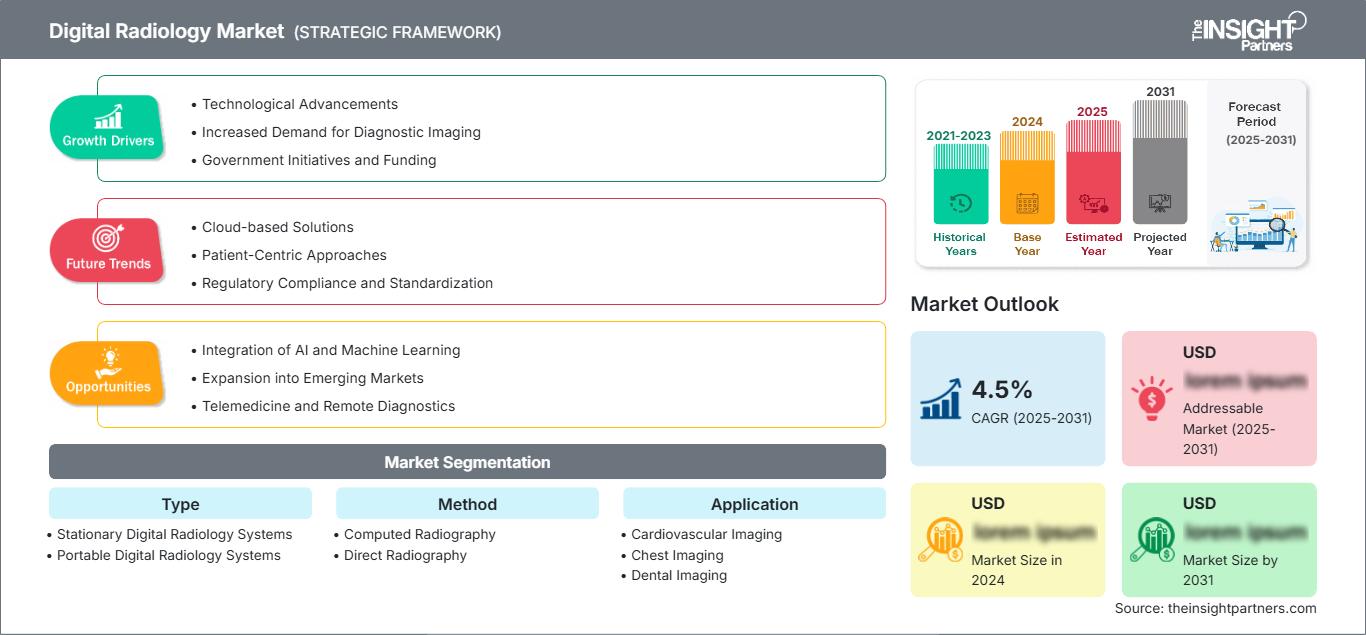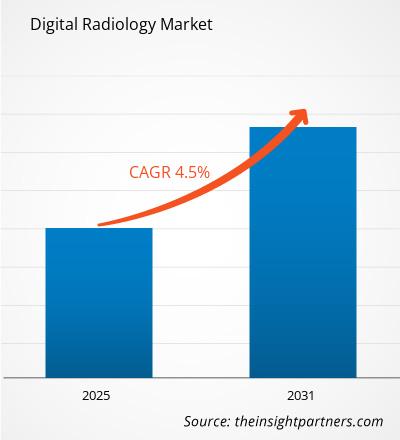Der Markt für digitale Radiologie wird voraussichtlich zwischen 2025 und 2031 eine durchschnittliche jährliche Wachstumsrate (CAGR) von 4,5 % verzeichnen, wobei die Marktgröße von XX Millionen US-Dollar im Jahr 2024 auf XX Millionen US-Dollar im Jahr 2031 anwachsen wird.
Der Bericht ist nach Typ (stationäre digitale Radiologiesysteme, tragbare digitale Radiologiesysteme) segmentiert. Der Bericht präsentiert außerdem eine Analyse basierend auf der Methode (Computerradiographie (CR), Direktradiographie (DR)). Der Bericht ist nach Anwendung (kardiovaskuläre Bildgebung, Thoraxbildgebung, zahnärztliche Bildgebung, Mammographiebildgebung, orthopädische Bildgebung, sonstige) segmentiert. Der Bericht ist nach Endbenutzer (Krankenhäuser und Kliniken, Diagnosezentren, sonstige) segmentiert. Die globale Analyse ist weiter auf regionaler Ebene und nach wichtigen Ländern aufgeschlüsselt. Der Bericht bietet den Wert in USD für die oben genannte Analyse und Segmente.
Zweck des Berichts
Der Bericht „Digital Radiology Market“ von The Insight Partners zielt darauf ab, die aktuelle Landschaft und das zukünftige Wachstum sowie die wichtigsten treibenden Faktoren, Herausforderungen und Chancen zu beschreiben. Dies wird verschiedenen Geschäftspartnern Einblicke bieten, wie z. B.:
- Technologieanbieter/-hersteller: Um die sich entwickelnde Marktdynamik zu verstehen und die potenziellen Wachstumschancen zu kennen, damit sie fundierte strategische Entscheidungen treffen können.
- Investoren: Um eine umfassende Trendanalyse hinsichtlich der Marktwachstumsrate, der finanziellen Marktprognosen und der Chancen entlang der Wertschöpfungskette durchzuführen.
- Regulierungsbehörden: Um Richtlinien und Überwachungsaktivitäten auf dem Markt zu regulieren, mit dem Ziel, Missbrauch zu minimieren, das Vertrauen der Investoren zu bewahren und die Integrität und Stabilität des Marktes aufrechtzuerhalten.
Marktsegmentierung für die digitale Radiologie: Typ
- Stationäre digitale Radiologiesysteme
- Tragbare digitale Radiologiesysteme
Methode
- Computerradiographie
- Direktradiographie
Anwendung
- Herz-Kreislauf-Bildgebung
- Thorax-Bildgebung
- Zahnärztliche Bildgebung
- Mammographie-Bildgebung
- Orthopädische Bildgebung
- Sonstige
Endbenutzer
- Krankenhäuser und Kliniken
- Diagnosezentren
- Sonstige
Sie erhalten kostenlos Anpassungen an jedem Bericht, einschließlich Teilen dieses Berichts oder einer Analyse auf Länderebene, eines Excel-Datenpakets sowie tolle Angebote und Rabatte für Start-ups und Universitäten.
Markt für digitale Radiologie: Strategische Einblicke

- Holen Sie sich die wichtigsten Markttrends aus diesem Bericht.Dieses KOSTENLOSE Beispiel umfasst Datenanalysen, die von Markttrends bis hin zu Schätzungen und Prognosen reichen.
Wachstumstreiber für die digitale Radiologie
- Technologischer Fortschritt: Der Hauptantrieb der digitalen Radiologie ist der rasante technologische Fortschritt. Fortschrittliche Bildgebungstechnologien wie die Computerradiographie (CR) und die digitale Radiographie (DR) verbessern die Bildqualität und damit die Diagnosefähigkeit. Sie sparen zudem erheblich Zeit bei der Bildaufnahme und -verarbeitung und bieten Gesundheitsdienstleistern eine aktuelle und fundierte Alternative. Fortschritte in den Bereichen KI und ML verbessern zudem die Bildanalyse, sodass Erkrankungen erkannt werden können, die dem bloßen Auge entgehen würden. Die Technologien entwickeln sich ständig weiter, und ihre Implementierungen schaffen eine steigende Nachfrage nach digitalen Lösungen für die Radiologie.
- Steigende Nachfrage nach diagnostischer Bildgebung: In der jüngeren Vergangenheit hat die Diagnose, einschließlich Krebs, Herz-Kreislauf-Erkrankungen und orthopädischen Leiden, ein enormes Tempo angezogen. Da die Weltbevölkerung immer älter wird, steigt der Bedarf an einer frühzeitigen Diagnose und angemessenen Behandlung solcher Erkrankungen. Daher ist die Nachfrage nach nicht-invasiven Diagnoseverfahren der digitalen Radiologie zur Diagnose solcher Krankheiten in Krankenhäusern und Kliniken gestiegen. Ein weiterer Aspekt ist die zunehmende Bedeutung der Präventivmedizin. Daher suchen Gesundheitsdienstleister nach digitalen Bildgebungslösungen, um Krankheiten frühzeitig zu erkennen.
- Regierungsinitiativen und -förderung: Regierungen weltweit haben erkannt, dass ein verbesserter Zugang zu modernen Diagnoseinstrumenten ihnen helfen wird, die negativen Auswirkungen auf die Gesundheit zu überwinden. Einige Länder haben bereits mit der Umsetzung von Förderprogrammen und Richtlinien begonnen, die die Einführung digitaler Radiologietechnologien unterstützen. Beispielsweise sind Investitionen in die Gesundheitsinfrastruktur im Rahmen von Reformen im Gesundheitswesen ein allgemeiner Trend, bei dem auch in digitale Bildgebungslösungen investiert wird. Der Zugang zu hochwertiger diagnostischer Bildgebung wird nicht nur die Zahl der Einrichtungen erhöhen, die ihre Systeme digitalisieren, sondern auch Gesundheitseinrichtungen dazu ermutigen, ihre Systeme auf digitale Formate umzustellen.
Zukünftige Trends im Markt für digitale Radiologie
- Cloudbasierte Lösungen: Cloudbasierte Lösungen werden in der digitalen Radiologie immer beliebter. Die verschiedenen technologischen Konfigurationen bieten Vorteile wie verbesserte Datenspeicherung, bessere Kommunikation zwischen den medizinischen Fachkräften und Zugriff auf Patientenakten. Digitale Radiologen können Bilder und Daten überall abrufen, da diese in der Cloud gespeichert sind. Dies erleichtert ihnen die Erstellung von Zweitmeinungen per Fernkonsultation. Diese Entwicklung fördert somit nicht nur die Effizienz der Arbeitsabläufe, sondern spart Gesundheitseinrichtungen auch die hohen Kosten für eine umfangreiche lokale IT-Infrastruktur.
- Patientenzentrierte Ansätze: Ein Trend zur patientenzentrierten Ausrichtung ist in allen Gesundheitsdienstleistungen zu beobachten, einschließlich der digitalen Radiologie. Dies erhöht den Druck auf Transparenz und das Recht des Einzelnen auf Zugang zu medizinischen Informationen und erhöht die Forderung nach einer stärkeren Einbindung der Patienten in deren Entscheidungen. Digitale Radiologielösungen, die Patienten einen einfachen Zugriff auf Bildergebnisse ermöglichen und die Kommunikation mit Gesundheitsdienstleistern erleichtern, gewinnen zunehmend an Bedeutung. Dieser Trend zielt im Wesentlichen auf die Aufklärung und Einbindung von Patienten in alle Gesundheitsdienstleistungen ab.
- Einhaltung gesetzlicher Vorschriften und Standardisierung: Der Trend zur Nutzung der digitalen Radiologie nimmt im Hinblick auf die Einhaltung gesetzlicher Vorschriften und Standardisierung zu. Da die Datengenerierung durch Bildgebungstechnologien offensichtlich ein beträchtliches Niveau erreicht hat, betonen Aufsichtsbehörden die Notwendigkeit standardisierter Protokolle sowohl für die Sicherheit als auch für die Wirksamkeit der Bildgebungsverfahren. Vorschriften wie der Health Insurance Portability and Accountability Act in den USA oder ähnliche Vorschriften in anderen Teilen der Welt stellen kritische regulatorische Hürden für digitale Lösungen in der Radiologie dar. Unternehmen, die Wert auf Compliance legen oder Branchenstandards einhalten, festigen und stärken ihren Ruf als solide und vertrauenswürdige Akteure auf dem Markt.
Marktchancen für die digitale Radiologie
- Integration von KI und maschinellem Lernen: Die digitale Radiologie wird durch die Integration von künstlicher Intelligenz und maschinellem Lernen große Wachstumschancen auf dem Markt eröffnen. Dies kann die Interpretation weiter verbessern, Arbeitsabläufe optimieren und menschliche Fehler reduzieren. Es geht sogar bis zur Automatisierung von Routineaufgaben, bei denen Radiologen mehr Zeit für komplexe Beurteilungen aufwenden müssten. Dies führt folglich zu einer Verbesserung der Patientenversorgung. Unternehmen, die KI-basierte Lösungen für die Bildinterpretation und -diagnostik anbieten, können von diesem Trend profitieren, indem sie Tools bereitstellen, die Radiologen dabei helfen, in kürzerer Zeit die genaueste Diagnose zu stellen.
- Expansion in Schwellenmärkte: Schwellenmärkte bieten auch Wachstumschancen für die digitale Radiologie. Die Verbesserung der Gesundheitsinfrastruktur in Ländern Asiens, Afrikas und Lateinamerikas wird die Nachfrage nach fortschrittlichen Lösungen für die diagnostische Bildgebung erhöhen. Investitionen dürften sich auszahlen, da Gesundheitseinrichtungen nach Möglichkeiten suchen werden, moderne Technologien zu nutzen, die ihre diagnostischen Möglichkeiten verbessern. Ebenso passen Unternehmen, die solche Dienstleistungen anbieten, ihre Produkte an die Bedürfnisse ihrer spezifischen Märkte an, beispielsweise in Bezug auf Erschwinglichkeit und Benutzerfreundlichkeit.
- Telemedizin und Ferndiagnostik: Telemedizin und andere Ferndiagnostikverfahren haben bereits begonnen, die gesamte Gesundheitsversorgung zu verändern. Die digitale Radiologie hat sich als integraler Bestandteil dieses Wandels herausgestellt, da sie einen effektiven und schnellen Bild- und Berichtsaustausch zwischen Anbietern ermöglicht. Telemedizinische Dienste nehmen stark zu, ebenso wie die enormen Möglichkeiten digitaler Radiologielösungen, die Zweitmeinungen und Konsultationen mit mehreren Spezialisten von jedem beliebigen Standort aus ermöglichen und so die Möglichkeiten der Gesundheitsversorgung weiter erweitern. Da sich Gesundheitssysteme zunehmend an dezentrale Versorgungsmodelle anpassen, wird der Markt für Unternehmen wachsen, die Plattformen entwickeln, die die vollständige Integration digitaler Bildgebung in die Telemedizin erleichtern.
Markt für digitale Radiologie
Die Analysten von The Insight Partners haben die regionalen Trends und Faktoren, die den Markt für digitale Radiologie im Prognosezeitraum beeinflussen, ausführlich erläutert. In diesem Abschnitt werden auch die Marktsegmente und die geografische Lage in Nordamerika, Europa, dem asiatisch-pazifischen Raum, dem Nahen Osten und Afrika sowie Süd- und Mittelamerika erörtert.Umfang des Marktberichts zur digitalen Radiologie
| Berichtsattribut | Einzelheiten |
|---|---|
| Marktgröße in 2024 | US$ XX million |
| Marktgröße nach 2031 | US$ XX Million |
| Globale CAGR (2025 - 2031) | 4.5% |
| Historische Daten | 2021-2023 |
| Prognosezeitraum | 2025-2031 |
| Abgedeckte Segmente |
By Typ
|
| Abgedeckte Regionen und Länder | Nordamerika
|
| Marktführer und wichtige Unternehmensprofile |
|
Dichte der Marktteilnehmer im Bereich der digitalen Radiologie: Verständnis ihrer Auswirkungen auf die Geschäftsdynamik
Der Markt für digitale Radiologie wächst rasant. Dies wird durch die steigende Nachfrage der Endnutzer aufgrund veränderter Verbraucherpräferenzen, technologischer Fortschritte und eines stärkeren Bewusstseins für die Produktvorteile vorangetrieben. Mit der steigenden Nachfrage erweitern Unternehmen ihr Angebot, entwickeln Innovationen, um den Bedürfnissen der Verbraucher gerecht zu werden, und nutzen neue Trends, was das Marktwachstum weiter ankurbelt.

- Holen Sie sich die Markt für digitale Radiologie Übersicht der wichtigsten Akteure
Wichtige Verkaufsargumente
- Umfassende Abdeckung: Der Bericht analysiert umfassend Produkte, Dienstleistungen, Typen und Endnutzer des Marktes für digitale Radiologie und bietet einen ganzheitlichen Überblick.
- Expertenanalyse: Der Bericht basiert auf dem umfassenden Verständnis von Branchenexperten und Analysten.
- Aktuelle Informationen: Der Bericht gewährleistet Geschäftsrelevanz durch die Berichterstattung über aktuelle Informationen und Datentrends.
- Anpassungsoptionen: Dieser Bericht kann an spezifische Kundenanforderungen angepasst werden und passt sich so optimal an die Geschäftsstrategien an.
Der Forschungsbericht zum Markt für digitale Radiologie kann daher dazu beitragen, die Branchensituation und die Wachstumsaussichten zu entschlüsseln und zu verstehen. Obwohl es einige berechtigte Bedenken geben mag, überwiegen die Vorteile dieses Berichts tendenziell die Nachteile.
- Historische Analyse (2 Jahre), Basisjahr, Prognose (7 Jahre) mit CAGR
- PEST- und SWOT-Analyse
- Marktgröße Wert/Volumen – Global, Regional, Land
- Branchen- und Wettbewerbslandschaft
- Excel-Datensatz
Aktuelle Berichte
Verwandte Berichte
Erfahrungsberichte
Grund zum Kauf
- Fundierte Entscheidungsfindung
- Marktdynamik verstehen
- Wettbewerbsanalyse
- Kundeneinblicke
- Marktprognosen
- Risikominimierung
- Strategische Planung
- Investitionsbegründung
- Identifizierung neuer Märkte
- Verbesserung von Marketingstrategien
- Steigerung der Betriebseffizienz
- Anpassung an regulatorische Trends




















 Kostenlose Probe anfordern für - Markt für digitale Radiologie
Kostenlose Probe anfordern für - Markt für digitale Radiologie